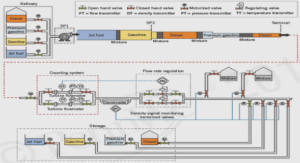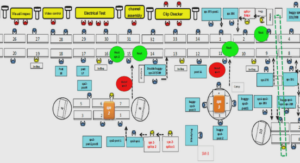A simple and eco-sustainable method for the O-Boc protection/deprotection
Introduction
Efforts have been made to identify mild and efficient chemoselective methods for the protection/deprotection of functional groups, crucial interest to organic multi-step synthesis [1,2]. Tert-butyl carbamates are widely used as amine-protecting groups in various fields of organicsynthesis due to its stability toward nucleophilic conditions and due to its easy removal in various environments. The insertion of Bocgroup is usually achieved using di-tert-butyl dicarbonate (Boc)2O, being the best available reagent used for protecting substrates containing a labile-hydrogen moiety such as phenol-type [3,4]. Acylation is a common approach in protecting hydroxyl groups [5,6], but its regeneration requires harsh conditions incompatible with polyfunctional molecules. Furthermore, O-tert-butoxycarbonylation is a suitable and preferred alternative process to protect hydroxyl group [1,2] due to both sustainable compatibility toward reaction conditions applied in organic synthesis and regeneration practices conducted under soft conditions. In the last decade, various methods and reagents have been developed to achieve the protection/ deprotection of Boc group on phenol functionality. The introduction of Boc moiety into phenols is generally achieved by the reaction of (Boc)2O in the presence of a phase transfer catalyst [7], 4-dimethylaminopyridine (DMAP) as catalyst [8] and using Lewis acids such as BiCl3 [9], Zn(OAc)2 [10], 1-tertbutoxy-2-tert-butoxycarbonyl-1,2-dihydroisoquinoline (BBDI) [3,4] and NaTiO4 [11], or using 6,7- dimethoxyisoquinoline [12] as an organocatalyst. On the other hand, the O-Bocdeprotection is carried out under mild acidic conditions such as trifluoroacetic acid (TFA) [13] and the use of a large excess of base [14]. In spite of their importance, there are a few methods available for the protection/ deprotection of O-Bocgroups under eco-sustainable conditions. Recently, Chankeshwara et al. [15] reported the O-tert-butoxycarbonylation of functionalized phenols using carbon tetrabromide (CBr4) as catalyst and their regeneration from the O-tert-Boc derivatives using the complex system CBr4PPh3. More recently, Procopio et al. [16] described a new method for the protection/deprotection of the O-tertbutoxy carbonates of alcohols and phenols using mesoporous silica-supported (ErIII-MCM-41). However, these conditions are not chemoselective, require harsh conditions, long reaction time, and nucleophilic organocatalysts used sometimes involve the generation of side products in significant *Corresponding author: Email: noureddineaouf@yahoo.fr Green Chemistry Letters and Reviews, 2013 http://dx.doi.org/10.1080/17518253.2012.738371 # 2013 Zinelaabidine Cheraiet, Sihem Hessainia, Souad Ouarna, Malika Berredjem and Nour-Eddine Aouf Downloaded by [CERIST] at 00:40 26 January 2013 quantities such as symmetrical carbonates, cyclic carbonates, and carboniccarbonic anhydrides [8]. In recent years, organic reactions in water have received considerable attention (1720). The use of water as a solvent offers several advantages suc h as improving reactivity and selectivity, mild reaction conditions, and minimization of energy requirements [21]. Thus, in the continuation of our previous work on the use of catalyst-free water-related system for the NBoc protection/deprotection (2224), we herein report an efficient protocol for O-tert-butoxycarbonyl protection/deprotection of phenol derivatives under catalyst-free conditions and in aqueous media, meeting all requirements for a green chemical process.
Results and discussion
In order to determine the best reaction system model, we chose phenol (Table 2, Entry 1) as model substrate and treated it with (Boc)2O (1 mmol) under catalystfree conditions in aqueous media at room temperature, and the expected product was obtained in excellent yield. To find the role of water in O-Boc protection, the reaction was performed in several polar solvents at room temperature (Table 1). The best result was obtained with water, affording tert-butyl phenyl carbonate in 95% yield after 45 min. The reaction was carried out under catalyst-free conditions in polar proticsolvents (MeOH and EtOH), affording, respectively, expected products in 10% and 4% yields after 72 h. The O-tert-butoxycarbonylation in polar aprotic solvents (THF, MeCN, CH3Cl, and CCl4) did not give any significant results. The readings of these results show well the efficacy of water in the O-Boc protection of phenol. Whereas, when the reaction carried using Table 1. Evaluation of different solvents for O-Bocprotection of phenol under catalyst-free conditions. Solvents Time (h) Yield (%) H2O 0.75 95 MeOH 72 10 EtOH 72 4 MeCN 72 0 THF 72 0 CH3Cl 72 0 CCl4 72 0 Table 2. O-Boc protection/deprotection of hydroxy compounds. O-Bocprotectiona O-Bocdeprotectionb Entry Substrate Product T (min)/yield (%) T (min)/yield (%) 1 OH OBoc 45/95 8/98 2 OH OMe OBoc OMe 30/87 3/95 3 OH NO2 NO2 OBoc 70/96 5/100 4 OH Br OBoc Br 55/90 8/90 5 Cl Cl Cl OH OBoc Cl Cl Cl 90/93 10/89 2 Z. Cheraiet et al. Downloaded by [CERIST] at 00:40 26 January 2013 polar and protic solvents under catalyst-free conditions, the corresponding carbonate is in failure. Only the properties of water molecule cause ‘‘electrophilic activation’’ making the carbonyl group more susceptible to the nucleophilic attack of phenol. What may be explained the role of water compared to other solvents. The amount of aqueous media has a significant effect on the reaction rate and product yield. The minimal required amount for O-Bocprotection is 5 mL/mmol (water:acetone 9.5:0.5). Increasing the amount of water to 710 mL/mmol affects the reaction rate by prolonging reaction time by 1.54 h in tert-butyl phenyl carbonate conversion, which could be explained by the outsized dispersion of reagents in the solution





